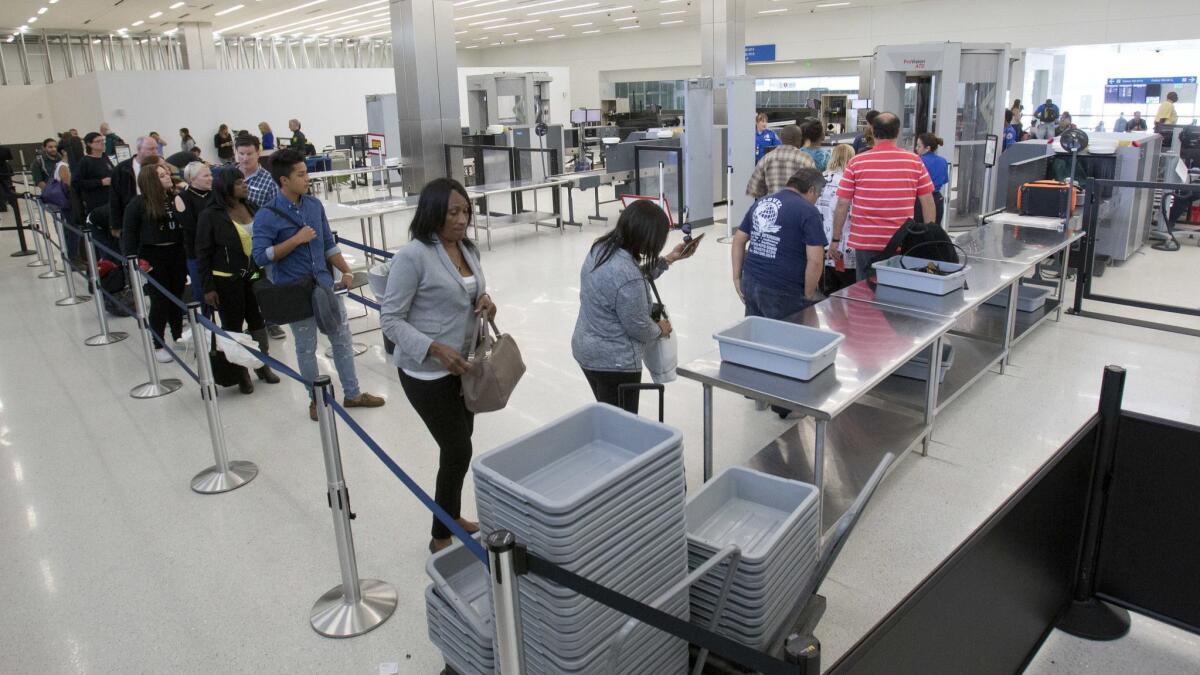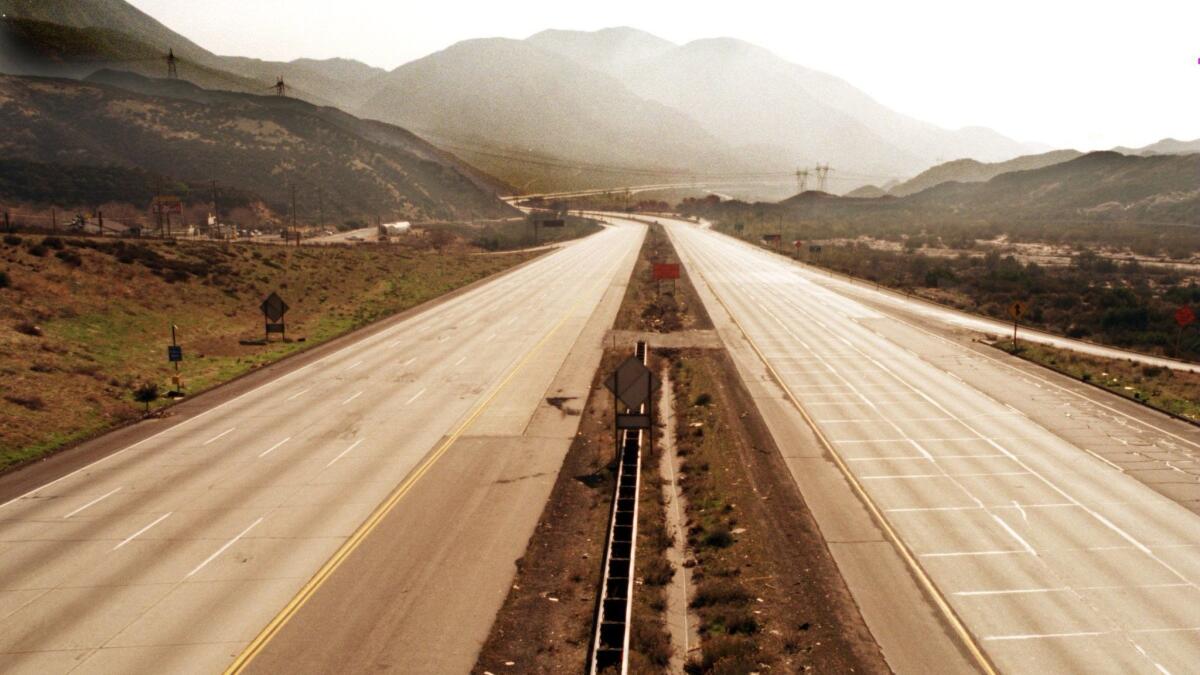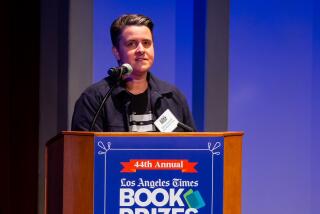America’s narrative has been disrupted, writes David L. Ulin
- Share via
Early in May 2017, the Transportation Security Administration initiated a pilot program at two domestic airports in which travelers were told to remove “paper products” — books, notebooks, and other documents— from carry-ons before X-ray screening. I know: at this point, when the news cycle seems to have sped up as if through time dilation, that reads like ancient history, especially since less than two months later, the TSA announced that testing had been completed and there were “no intentions of instituting those procedures” nationwide.
All the same, we’ve been here before. In October 2001, the American Library Association announced its opposition to the Patriot Act, particularly Section 215, the so-called “library records provision,” which required librarians to turn over the records of patrons when asked to do so by law enforcement.
That provision was sunsetted out of existence in 2015, but the aftereffect lingers like (to borrow a phrase from Don DeLillo) an airborne toxic event. “Censorship is never over for those who have experienced it,” Nadine Gordimer once observed. “It is a brand on the imagination that affects the individual who has suffered it, forever.”
What she’s describing is a state of fear. Something similar might be said in regard to the TSA, which is not in the business of security so much as it is in the business of “security theater”: “a form of ‘magical thinking,’ ” Bruce Schneier, a fellow at Harvard University’s Berkman Klein Center for Internet & Society, has written, that “relies on the idea that we can somehow make ourselves safer by protecting against what the terrorists happened to do last time.”

Schneier’s right. There is no point, no value, in making travelers take off their shoes because one time, a lone individual tried to blow up an airplane with a sneaker bomb. In the United States, however, we have lost the thread of logic in the stories that we tell.
Just think about the headlines during the first twelve months of the Trump administration: the Muslim ban and the immigration raids, the Russia investigation, the paid-off porn star. Just think about the racist rhetoric that runs, like excrement, from the president’s mouth.
On the one hand, America has always been a racist country. On the other, that has never before been rendered as acceptable. No, we are in the midst of a broken story, and we have lost the ability to parse its lines.
David L. Ulin launches the new edition of “The Lost Art of Reading” Tues. Sept 4, 7:30 p.m. at Skylight Books.
Stories, I’ve long believed, are connective, the only tool we have to reach out of our isolation, regardless of how fleetingly. This is as close as I get to faith, this notion that narrative can save us, even (or especially) if we cannot, finally, be saved.
And yet, living in this place and time, I wonder whether that’s another disrupted narrative.
What if stories are not what we need, not what brings us together, but rather, as Schneier asserts, “what we fear”? Let’s stay with that line of thought for a moment, because stories can be dangerous things. Those white supremacists in Charlottesville, with their Tiki torches and their khakis, were telling a story I would have thought we’d put behind us, until the election of 2016 made me realize how naïve I’d been.
It’s not that I believed racism, supremacy, had been vanquished; how could I, in a nation where, according to the Guardian, African American men between 15 and 34 were nine times more likely to be killed by police in 2016 than other Americans?

This is the narrative (or one of them) the supremacists and neo-Nazis sought to embody in Virginia: “You will not replace us,” they chanted as they marched. The phrase derives from a 2012 book by the French writer Renaud Camus called “Le Grand Remplacement,” which argues that Europe is being “reverse colonized” by immigrants of color, a clash of civilizations that amounts to an existential threat.
This is a ridiculous narrative, but it has staying power, going back to Cain and Abel, Exodus. What do we do with those we label other? For Camus, as for those in Charlottesville, the answer is simple: get rid of them. Here, we see the story trumpeted by the president from the first day of his campaign, and if you don’t think that’s important, consider the permission it bestowed, for instance, on James Alex Fields Jr., who killed thirty-two-year-old Heather Heyer and injured dozens of others when he drove his car into a crowd of counterprotesters.
As a culture, we are experiencing the collapse of collective narrative: left and right relying on their own news sources, Raw Story and the Daily Caller, MSNBC and Fox News. Not only that, but even the factions are factionalized, and have been since at least the 1960s. Purity, the rabid fervor of the true believer (the same for all extremists, left and right), versus pragmatism, competence. I have been on both sides, and I cannot say what I now believe.

Last winter, not long after the inauguration, I moved for four months to Las Vegas, which means I spent a lot of time driving through the rural West. Every few weeks, I would return to Los Angeles to see my wife and children: four hours, 273 miles through the Mojave, the Angeles National Forest, Primm, Baker, Barstow, Victorville, Ontario, like a lost verse from a pop song about the open road.
This, too, is a story, or perhaps more accurately, several stories. “We were somewhere around Barstow on the edge of the desert,” Hunter S. Thompson begins “Fear and Loathing in Las Vegas,” “when the drugs began to take hold.” Whatever these towns may once have been, they are now roadside stops like any other, fast-food joints and outlet malls, snacks and cigarettes and gas. The great American homogenization, in which chains and cheap construction have yielded a landscape where towns appear interchangeable, although beneath their bland and echoed surfaces, I’m sure, beat distinct and differentiated hearts.
The first time I made this drive — or one like it — was in 1968, on a family trip. I was not quite seven years old. Just past Barstow, we made the turnoff for Interstate 40, passing first through Needles, California, then Arizona; we would take three weeks to travel east. Then, as now, we were a nation divided, as we were once more in the 1980s, when I traversed these roads again. For hundreds of miles, radio gave up only farm reports and God talk, and when I stopped to eat or sleep or fill the tank, I was never unaware that I was a stranger in a strange land. “You a Jew, boy?” someone once asked in a small town in South Texas, and although he wasn’t exactly threatening (more curious, I want to tell you), there was a moment when I wasn’t sure how to respond.
Still, how strange could this land be if it were also so accessible, so available to me? I-40, for instance: it would carry me across New Mexico into the Texas Panhandle, Oklahoma, Arkansas, Tennessee. I-15, were I to stay on past Las Vegas, would eventually bring me to Salt Lake City, Butte. There used to be a mileage sign in Wilmington, North Carolina, not far from I-40’s terminus; “Barstow, Calif. 2,554,” it declared. You might read that sign as information or as metaphor, but for me it was an emblem of the commons, of the country as a landscape we all share.
“A story can take you through a whole process of searching, seeking, confronting, through conflicts, and then to a resolution,” Maxine Hong Kingston writes in “The Woman Warrior,” and not unlike her, this is the narrative I want to share.
And yet, every narrative is conditional — isn’t that what reading has to tell us? Every narrative is a slice of a larger whole. “All stories, if continued far enough, end in death,” Ernest Hemingway notes in “Death in the Afternoon,” “and he is no true-story teller who would keep that from you.” He’s right, although it is also the case that most stories don’t continue far enough, which means we have no choice but to engage with them as part of a continuum. Those narratives, they exist on either end of the page, before the action opens and after it is done.
I don’t mean to trivialize our situation by referring to it through the lens of narrative, but rather to contextualize. This is how the world works: first we tell ourselves a story, then we dream our way inside it as a way of bringing it to life. It’s why we have to be careful about the narratives we evoke or create, because they are bound by (or they bind) the limits of what we can imagine, the limits of our ability to think. The reason books and reading remain essential is because they are still the most effective mechanisms by which to crack open the universe. Think about it: when we read, we soul travel, in the sense that we join, or enter, the consciousness of another human. We empathize — we have to — because our experience is enlarged.
David L. Ulin is a 2015 Guggenheim fellow, and the former book editor and book critic of the Times. This essay is excerpted from the second edition of his book “The Lost Art of Reading,” which comes out Tuesday.
More to Read
Sign up for our Book Club newsletter
Get the latest news, events and more from the Los Angeles Times Book Club, and help us get L.A. reading and talking.
You may occasionally receive promotional content from the Los Angeles Times.










